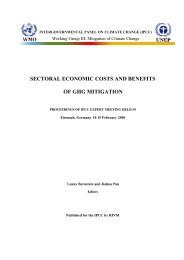Pacific Islands Environment Outlook - UNEP
Pacific Islands Environment Outlook - UNEP
Pacific Islands Environment Outlook - UNEP
You also want an ePaper? Increase the reach of your titles
YUMPU automatically turns print PDFs into web optimized ePapers that Google loves.
6<br />
STATE OF THE ENVIRONMENT<br />
local knowledge and management systems has been<br />
strongly stated by PIDCs and research that focuses on<br />
indigenous knowledge and natural resource<br />
management practices is received with growing<br />
enthusiasm in the <strong>Pacific</strong>.<br />
Conclusion<br />
The extremely limited and vulnerable land resource<br />
base of most PICs means that the sustainable<br />
management of land will become an increasingly<br />
important issue in the region. In a 1992 survey, some<br />
75 per cent of the region’s countries mentioned<br />
degradation of land, in particular coastal land, as a<br />
major environmental concern.<br />
High population growth rates, increased individual<br />
requirements for land, the displacement of traditional<br />
land management systems by new agricultural systems,<br />
mining and forest utilization have all placed serious<br />
stress on land resources and the communities that<br />
depend on them. Where good arable land is in short<br />
supply, as in Fiji and Samoa, subsistence gardening has<br />
been forced into increasingly marginal areas. Where only<br />
a small proportion of land is used for farming, as in PNG<br />
and Solomon <strong>Islands</strong>, there is intensive production within<br />
existing farmed areas.<br />
The potential threat to the productivity of land<br />
resources posed by global climate change is expected to<br />
heighten further the need for sustainable land<br />
management in the years to come.<br />
The fact that very few PICs have developed land-use<br />
policies and that even fewer countries are effectively<br />
implementing such policies is of considerable concern. It<br />
is essential that efforts to develop and implement<br />
sustainable land management policies are given the<br />
priority that the issue deserves.<br />
Forests<br />
Developments over the past 100 years<br />
Forests are of ecological, social, cultural and<br />
commercial importance. In most PICs deforestation was<br />
not a serious issue until relatively recently. It is<br />
believed that prior to European contact, inhabitants on<br />
most islands did not cause substantial deforestation or<br />
forest degradation since populations were relatively<br />
small, commercial activities were absent and steel tools<br />
were unknown. However, following European<br />
colonization in the mid- to late 1800s, deforestation and<br />
forest degradation accelerated rapidly on most islands.<br />
Coastal and lowland forests were converted to largescale<br />
commercial coconut, cocoa and banana plantations<br />
on many islands, and this process was facilitated by the<br />
introduction of new technologies such as steel tools and<br />
mechanized transport. Forest conversion has<br />
accelerated in recent decades as populations have<br />
increased, as more efficient methods and tools for<br />
removing forest, such as chain saws, have become more<br />
widely available, and as commercial imperatives, such as<br />
timber logging and the development of commercial<br />
agriculture, have become more important.<br />
Although some countries have increasingly effective<br />
systems of forestry reserves, conservation areas and/or<br />
national parks to protect their forests for science and<br />
humanity, few, if any, have legislation or institutionalized<br />
programmes prohibiting the cutting or promoting the<br />
replanting, on a significant scale, of endangered tree<br />
species. This is threatening the local and regional<br />
biodiversity which constitutes the economic and cultural<br />
backbone of many <strong>Pacific</strong> peoples.<br />
Developments over the past 10 years<br />
Few data are available to show exactly how serious the<br />
loss of intact forest has been since the Asian<br />
Development Bank (ADB) report in 1992. However, in<br />
some countries of the region, such as Samoa, rates of<br />
deforestation in recent years have approached 2 per cent<br />
per annum (GOWS 1994; Martel in prep.), faster than the<br />
estimated rate at which tropical forests are being cleared<br />
in the world (0.8 per cent per annum 1980–90) and in<br />
tropical Asia (1.2 per cent per annum (FAO 1998)). In<br />
the FSM, aerial photography of Pohnpei taken in<br />
November 1995 showed that only 15 per cent of the land<br />
was under undisturbed forest, compared to 42 per cent in<br />
1976 (FSM Country Report 1996).<br />
The percentage of forest cover in some <strong>Pacific</strong> island<br />
countries is shown in Figure 1.2.<br />
The development of non-wood forest products<br />
(NWFPs) as an alternative income-generating activity (to<br />
timber) is being given more attention, especially through<br />
the initiatives of a number of Non-Governmental<br />
Organizations (NGOs). Among the NWFPs and activities<br />
being promoted are forest tree nuts (e.g. Ngali nuts),<br />
traditional medicinal plants, bee-keeping, Morinda<br />
citrifolia juice and leaves and butterfly farming.<br />
Forest and tree cover is diminishing in PICs due to a<br />
combination of population pressures, loss of traditional<br />
controls, shifting cultivation under population pressure,<br />
pasture development, mining and logging activities. Much<br />
publicity has been given to the increasing impact of<br />
logging operations in recent years, particularly in PNG

















